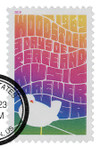
# 5409 - 2019 First-Class Forever Stamp - Woodstock
US #5409
2019 Woodstock
• Commemorates the 50th anniversary of the Woodstock Music and Art Fair in Bethel, New York, in August 1969.
Stamp Category: Commemorative
Value: 55¢ First Class Mail Rate (Forever)
First Day of Issue: August 8, 2019
First Day City: New York, New York
Quantity Issued: 30,000,000
Printed by: Banknote Corporation of America
Printing Method: Flexographic, Microprint
Format: Panes of 20
Tagging: Phosphor, Block Tagged
Why the stamp was issued: In honor of the 50th anniversary of the famous Woodstock Music Art Fair held in August 1969.
About the stamp design: Pictures a digital illustration of the dove from artist Arnold Skolnick’s promotional 1969 poster for Woodstock along with some of the poster’s words: “3 Days of Peace and Music.” The words are stacked in the background in bright colors with “1969,” “USA,” and “Forever.”
First Day City: First Day of Issue Ceremony was held at the “Play it Loud: Instruments of Rock & Roll” event at the Metropolitan Museum of Art in New York City.
History the stamp represents: In August 1969, thousands of people flocked to a New York farm for a weekend of peace, love, and music. Despite overcrowding, rain, and food shortages, they proved peace could win over hate and violence.
During the turbulent 1960s, the hippie culture opposed traditional values and violence. In 1969, four visionaries saw a chance to bring people together and show the world there was another way to live – with freedom and love. They chose to share their message through a music festival in Bethel, New York, near Bob Dylan’s hometown of Woodstock.
The organizers planned for 200,000 people, but more than 400,000 attended. Over three days, 32 acts shared their messages of peace. Among them were The Grateful Dead, Janis Joplin, and Jimi Hendrix. Huddled together in the rain, dancing in the mud, and sharing food and water, the attendees showed that even in harsh conditions, peace could prevail.
The 1970 documentary Woodstock won an Academy Award, further cementing the festival’s place in our culture. The site of the 1969 festival now hosts a museum and was also added to the National Register of Historic Places. Woodstock ’69 inspired countless music festival and anniversary concerts around the world, but none have ever had the cultural impact of the original.
US #5409
2019 Woodstock
• Commemorates the 50th anniversary of the Woodstock Music and Art Fair in Bethel, New York, in August 1969.
Stamp Category: Commemorative
Value: 55¢ First Class Mail Rate (Forever)
First Day of Issue: August 8, 2019
First Day City: New York, New York
Quantity Issued: 30,000,000
Printed by: Banknote Corporation of America
Printing Method: Flexographic, Microprint
Format: Panes of 20
Tagging: Phosphor, Block Tagged
Why the stamp was issued: In honor of the 50th anniversary of the famous Woodstock Music Art Fair held in August 1969.
About the stamp design: Pictures a digital illustration of the dove from artist Arnold Skolnick’s promotional 1969 poster for Woodstock along with some of the poster’s words: “3 Days of Peace and Music.” The words are stacked in the background in bright colors with “1969,” “USA,” and “Forever.”
First Day City: First Day of Issue Ceremony was held at the “Play it Loud: Instruments of Rock & Roll” event at the Metropolitan Museum of Art in New York City.
History the stamp represents: In August 1969, thousands of people flocked to a New York farm for a weekend of peace, love, and music. Despite overcrowding, rain, and food shortages, they proved peace could win over hate and violence.
During the turbulent 1960s, the hippie culture opposed traditional values and violence. In 1969, four visionaries saw a chance to bring people together and show the world there was another way to live – with freedom and love. They chose to share their message through a music festival in Bethel, New York, near Bob Dylan’s hometown of Woodstock.
The organizers planned for 200,000 people, but more than 400,000 attended. Over three days, 32 acts shared their messages of peace. Among them were The Grateful Dead, Janis Joplin, and Jimi Hendrix. Huddled together in the rain, dancing in the mud, and sharing food and water, the attendees showed that even in harsh conditions, peace could prevail.
The 1970 documentary Woodstock won an Academy Award, further cementing the festival’s place in our culture. The site of the 1969 festival now hosts a museum and was also added to the National Register of Historic Places. Woodstock ’69 inspired countless music festival and anniversary concerts around the world, but none have ever had the cultural impact of the original.











